NVIDIA CEO Jensen Huang and SpaceX CEO Elon Musk presented the new NVIDIA DGX Spark, a compact AI system, at an event held at Starbase in Texas on October 13. The device, which weighs just 1.18 kilograms, is designed to deliver one petaflop of computing performance for local artificial intelligence development.
Key Takeaways
- NVIDIA launched the DGX Spark, a compact AI system delivering 1 petaflop of performance.
- The unveiling took place at SpaceX's Starbase facility, with Jensen Huang presenting the first unit to Elon Musk.
- The system is powered by the GB10 Grace Blackwell chip and includes 128 GB of unified memory.
- Key manufacturing partners include ASUS, Dell, HP, and Lenovo, with orders beginning October 15.
- The DGX Spark aims to make high-performance AI computation more accessible for local development.
A Symbolic Handover Echoing AI History
The presentation on October 13 at Starbase was designed to be a significant moment, deliberately recalling a similar event in 2016. On that occasion, Jensen Huang delivered the first NVIDIA DGX-1 to Elon Musk. That earlier machine is now widely recognized for its role in accelerating the development of large-scale AI models, including those that led to technologies like ChatGPT.
By recreating this moment, NVIDIA is signaling its intention for the DGX Spark to play a similarly pivotal role in the next wave of AI innovation. Huang described the initiative as a move to "democratize AI," emphasizing the goal of putting powerful computational tools directly into the hands of more developers and researchers.
The Legacy of the DGX-1
The original NVIDIA DGX-1, launched in 2016, was a groundbreaking system that packed the power of hundreds of servers into a single box. It provided the necessary horsepower for training deep neural networks, which was a major bottleneck at the time. Its delivery to Musk, a key figure at OpenAI back then, marked a turning point in making advanced AI research feasible for more organizations.
Technical Specifications and Performance
The NVIDIA DGX Spark is a small but powerful device engineered for demanding AI tasks. Its compact form factor is one of its most notable features, making high-performance computing more portable and accessible than ever before.
Core Hardware Components
At the heart of the DGX Spark is the GB10 Grace Blackwell chip, a processor co-developed by NVIDIA and MediaTek. This chip is specifically designed to handle the complex calculations required for modern AI workloads. It is paired with 128 GB of LPDDR5X unified memory, which allows the system to process large datasets and complex models efficiently without memory bottlenecks.
The DGX Spark delivers 1 PetaFLOP of AI performance while consuming only 170 watts of power. This combination of high output and low energy use is a key engineering achievement, making it suitable for office or lab environments without specialized power infrastructure.
The system's specifications are tailored for developers who need to iterate quickly on AI models without relying on remote data centers. The complete package weighs only 1.18 kilograms (approximately 2.6 pounds), making it a truly portable AI supercomputer.
- Processor: NVIDIA GB10 Grace Blackwell
- Memory: 128 GB LPDDR5X Unified Memory
- Performance: 1 PetaFLOP
- Power Consumption: 170 watts
- Weight: 1.18 kg
Strategy to Decentralize AI Development
A primary goal behind the DGX Spark is to shift AI development away from a complete reliance on large, centralized cloud platforms. By providing a powerful local computing solution, NVIDIA aims to empower individual developers, researchers, and smaller teams to build and test sophisticated AI applications directly on their own hardware.
"Our goal is to democratize AI by placing powerful compute in more hands," Huang stated during the presentation, highlighting the company's vision for a more distributed AI ecosystem.
This approach addresses several challenges in the current AI landscape. Dependence on cloud services can lead to high operational costs, data privacy concerns, and latency issues. A local system like the DGX Spark gives users more control over their development environment and can significantly reduce the time it takes to experiment with new ideas.
For academic institutions and research labs, this accessibility is particularly important. It lowers the barrier to entry for conducting cutting-edge AI research, which has traditionally been limited to organizations with massive budgets for computational resources.
Broad Industry Support and Availability
NVIDIA has secured a strong network of partners to ensure the DGX Spark reaches a wide audience. The company is not handling manufacturing alone; instead, it is leveraging the production and distribution capabilities of some of the biggest names in computing.
Manufacturing and Early Adoption
The system will be manufactured by established hardware companies, including ASUS, Dell, HP, and Lenovo. This partnership strategy is expected to ensure a stable supply chain and broad global availability. Orders for the DGX Spark are set to open on October 15, indicating a rapid go-to-market plan.
Even before its official launch, the DGX Spark has attracted interest from major technology companies and academic institutions. Early adopters include:
- Microsoft
- Anaconda
- NYU’s Global Frontier Lab
The involvement of these organizations underscores the industry's enthusiasm for a compact, high-performance AI platform. For companies like Microsoft and Google, it offers a new tool for their internal research and development teams. For academic centers like NYU, it provides a powerful resource for training the next generation of AI experts and pushing the boundaries of scientific discovery.
The DGX Spark represents more than just a new piece of hardware. It is a strategic move by NVIDIA to shape the future of AI development, making it more accessible, efficient, and distributed. By placing a petaflop of computing power into a small, energy-efficient package, the company aims to fuel a new era of innovation from developers and researchers around the world.





